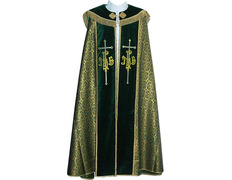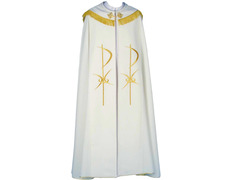Catholic Cope | Priest Vestment
Liturgical copes are an essential part of the vestments worn by priests, deacons, and bishops during various religious celebrations. This article will provide an in-depth look at the history, significance, and use of liturgical copes in the Christian tradition.
The liturgical cope has its origins in the early Christian church, where it was initially a simple cloak worn by clergy during processions and other outdoor ceremonies. Over time, the cope evolved into a more elaborate and ornate garment, reflecting the growing importance of the clergy in the Christian tradition. By the Middle Ages, the cope had become a symbol of authority and was worn by bishops, priests, and deacons during various liturgical celebrations.
The appearance of the ecclesiastical copes has not changed much since then. The main changes that have occurred in the appearance of the Catholic copes have been two.
In the first place, the front strips or bands that usually decorate the pluvial layers. The bands or strips widened markedly from the primitive copes. In addition, a fibula or brooch has been incorporated to close the on the vestment chest. The brooch allows priests to wear the garment comfortably.
Secondly, there has been a very significant change in the hood that the primitive pluvial layers incorporated. In the first place, the capes, designed to be used in processions, incorporated a hood that protected the priest's head in case of rain. Pluvial capes began to be used in all kinds of ceremonies, both outside and inside. The hood, over the years, lost functionality. For this reason, gradually, the hood was replaced by a purely ornamental element.
Liturgical copes are rich in symbolism, with their design and ornamentation often reflecting the specific liturgical season or feast being celebrated. For example, copes worn during Advent and Lent may feature more somber colors and designs, while those worn during the Christmas and Easter seasons may be more elaborate and vibrant. The cope is also a symbol of the priest's role as a shepherd, with the garment's ample folds representing the protection and guidance provided by the clergy to their flock.
Liturgical copes are available in a wide range of styles and materials, with many modern copes featuring intricate embroidery, appliqué, and other decorative elements. Some of the most common materials used in the construction of copes include silk, brocade, and damask, with the choice of fabric often reflecting the specific liturgical season or celebration. In addition to the main body of the cope, the garment also features a clasp or morse, which is used to fasten the cope at the front and may be adorned with jewels, enamel, or other decorative elements.
Liturgical copes are worn by priests, deacons, and bishops during various catholic celebrations, including processions, Benediction of the Blessed Sacrament, and the celebration of the Eucharist. The cope is typically worn over the alb and stole, with the garment's ample folds providing an additional layer of warmth and protection during outdoor ceremonies. In some cases, the cope may also be worn by lay ministers or other members of the congregation during specific liturgical celebrations.
The price of liturgical copes can vary based on a number of criteria.
The main factor that determines the price of a cope, as in many other liturgical vestments, is the fabric in which it is made. For example, silk copes will have a high price tag, while raincoats made of brocaded fabric or polyester will have a lower purchase price.
We must take into account the decoration of the garment when determining the sale price of a rain layer. Embroidery, trim, fringes, tassels, brooches, etc… are some of the elements that usually decorate the raincoats. Depending on the complexity of the embroideries, and the materials that the trims, fringes, etc. are made of, the price of a rain cape will vary.
Proper care and maintenance are essential to ensure the longevity and beauty of liturgical copes. This includes regular cleaning and inspection, as well as the use of appropriate storage methods to protect the garment from damage. When cleaning a liturgical cope, it is essential to follow the manufacturer's instructions and use gentle, non-abrasive cleaning methods to preserve the delicate fabrics and ornamentation.
In conclusion, liturgical copes are an essential part of the vestments worn by clergy during various religious celebrations. With their rich history, symbolism, and variety of styles and materials, copes serve as a powerful reminder of the role and responsibilities of the clergy in the Christian tradition. By understanding the significance and proper care of these garments, we can better appreciate their importance in the liturgical life of the Church.
Copes are catholic vestments. The name of cope has its origin in Italy (10th century). This kind of vestments was originally a catholic garment worn by priests in processions and other outdoor ceremonies to protect themselves from the cold and rain. To this end, the cope incorporated a hood to cover the head of the priests from inclement weather.

Ref: 84FKP14

Ref: 56F09P